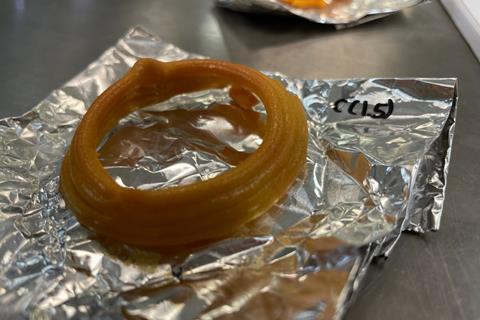Food scientists at the National University of Singapore have developed a new way to simulate seafood and used it to make food that mimics calamari rings, which they report can successfully be air-fried for a tasty and promising imitation of the real thing. The work was presented at the autumn meeting of the American Chemical Society, held virtually and in San Francisco, California.
The team made a paste from microalgae protein and mung bean protein extracted in the lab and combined with it plant-based oils rich in Omega-3 fatty acids to achieve a squid-like nutritional profile. Temperature changes allowed the paste to be squeezed out of a 3D printer’s nozzles and layered into rings. This food grade ink was deposited layer by layer to create different textures in their final product, some of which are fatty and smooth and others fibrous and chewy. The researchers say that after being cooked in an air fryer and deep fryer, the rings take on textures similar to that of actual calamari.

The 3D-printed squid has more than double the protein content of real calamari rings – approximately 20% protein versus 8% – and a similar fat content, according to Poornima Vijayan, a graduate student involved in the research. ‘We can also do some micronutrient enhancement to improve the nutritional profile of the product,’ stated Vijayan.
‘We have tried the air-fried calamari rings, and definitely they have a crispy texture on the outside and the interior was a bit chewy, which is comparable to a real calamari rings that we get in the market,’ she recalled. ‘But full-scale consumer research is still pending, and consumer acceptability still needs to be vetted on this product.’
The researchers emphasised that some microalgae already have a ‘fishy’ taste that makes them amenable for use in a seafood analogue, while the mung bean protein is an underused waste product from manufacturing starch noodles that are used in many Asian dishes.
Dejian Huang, who led the project, said there are many ways to commercialise his team’s new approach to creating vegan imitation seafood in the future. For one, the 3D printer they used is about the size of a typical microwave oven, so he stated that it could potentially be sold to individual households and his team could distribute the food ink so that consumers could print various foods at home. Such a machine could also be sold to restaurants, he added.
But Huang said large-scale production that would allow the artificial calamari rings to be sold in grocery stores, for example, will require a scalability of the microalgae and the mung bean protein supplies that doesn’t currently exist. ‘That will take a bit more effort, but I think that is not much of a technology hurdle … and in the near future we hopefully can have this healthy snack in the grocery store,’ he stated.
More prototypes expected
The researchers are hopeful that the product they ultimately develop will enable those with seafood allergies to enjoy the taste and nutritional content of squid. However, they noted that some people could be allergic to this new combination of microalgae and mung bean proteins. Their ultimate goal is to develop several prototypes and assess how easily they can be ramped up for larger scale production.
3D food printing is a growing area of research. For example, earlier this year a team led by Jonathan Blutinger from Columbia University in New York created a seven-ingredient vegan cheesecake with a 3D printer and laser technology.
Blutinger, who wasn’t involved in the calamari project, tells Chemistry World that the Singapore team’s findings are ‘definitely interesting’.
‘When you are trying to replicate meat and seafood, 3D printing is particularly good because you have control over the directionality of the printed food,’ he says. ‘Muscles contract in a certain direction and are stronger in a certain direction, for example, and that can be replicated here – you are able to dial in more on the internal structure of the material.’
But Blutinger questions whether the new material will fully achieve the particular texture of calamari.
‘The descriptions that they used in terms of the outside and inside textures of the final calamari product seem a little bit vague,’ he states. ‘With real calamari, that crispiness on the outside will separate from the inside, and you are left with the gummy material,’ he says, noting that the researchers’ photo and the video make it look like their simulated calamari has a fairly uniform texture throughout.
Blutinger is more curious about the chemistry of the material that the team created, as opposed to the manufacturing method. He says it is important get more feedback about how the texture of their imitation calamari compares to the real thing – qualitatively with official taste testers, and quantitatively with tools like a compression testing machine that can read the force feedback. ‘Such machines can be used to pull these materials slowly in real time and compare the two in terms of stringiness or gumminess, and then dial it to the actual texture of real calamari,’ he explains.
Christen Cooper, founder of the nutrition and dietetics department at Pace University in New York and who worked with Blutinger on the synthetic cheesecake, says digital cooking technologies have the potential to help people with special nutritional needs, particularly those with swallowing disorders that require soft or pureed diets. However, she also warns that such efforts could disrupt the so-called food matrix: ‘When we start breaking down foods, isolating certain components and placing the components in places they haven’t been before, we don’t know if we’ll see the same human nutrition benefits or not.’

















1 Reader's comment